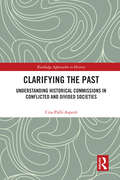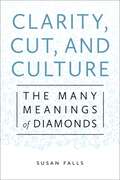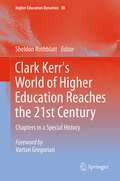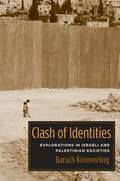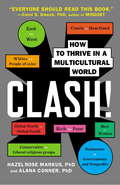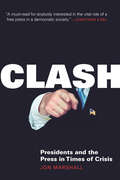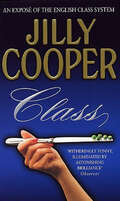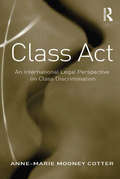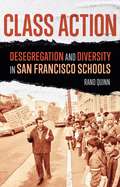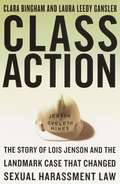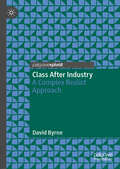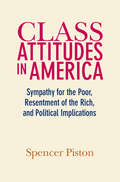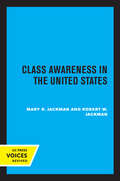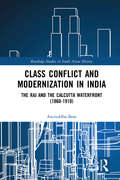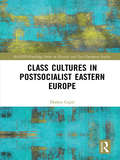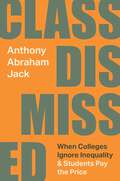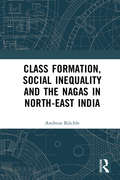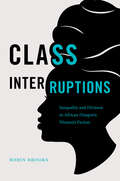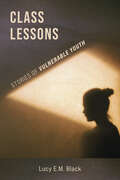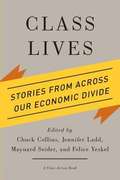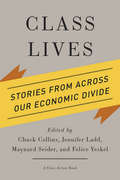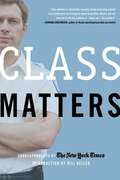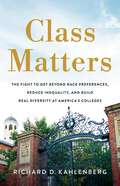- Table View
- List View
Clarifying the Past: Understanding Historical Commissions in Conflicted and Divided Societies (Routledge Approaches to History)
by Cira Pallí-AsperóClarifying the Past provides a comprehensive analysis of state-sponsored historical commissions operating in conflicted and divided societies, developing a theoretical and methodological framework within the historical dialogue paradigm, key to understanding the work of such commissions. The theoretical and methodological framework is complemented with an extensive empirical analysis of 27 historical commissions that operated in different social and political contexts from 1990s to the present. The detailed examination of these cases gives a broad perspective into the potential capacities of historical commissions in different settings. Although only sampling the most recent cases, this volume shows how the steady increase of the number of historical commissions indicates that we are not dealing with a marginal phenomenon. The increased recognition of the potential of historical commissions to address the legacies of contested pasts and potential introduction of such commissions to transitional justice, makes this book highly relevant. This book has been written with the objective of deepening and broadening the existing knowledge on state-sponsored historical commissions. Its intended audiences are scholars and practitioners in the fields of historical theory, public history, and historical dialogue, transitional justice, peace and conflict studies.
Clarissa's Ciphers: Meaning and Disruption in Richardson's Clarissa
by Terry CastleAs Samuel Richardson's 'exemplar to her sex,’ Clarissa in the eponymous novel published in 1748 is the paradigmatic female victim. In Clarissa’s Ciphers, Terry Castle delineates the ways in which, in a world where only voice carries authority, Clarissa is repeatedly silenced, both metaphorically and literally. A victim of rape, she is first a victim of hermeneutic abuse. Drawing on feminist criticism and hermeneutic theory, Castle examines the question of authority in the novel. By tracing the patterns of abuse and exploitation that occur when meanings are arbitrarily and violently imposed, she explores the sexual politics of reading.
Clarity, Cut, and Culture: The Many Meanings of Diamonds
by Susan FallsWhat our obsession with diamonds reveals about our material cultureImages of diamonds appear everywhere in American culture. And everyone who has a diamond has a story to tell about it. Our stories about diamonds not only reveal what we do with these tiny stones, but also suggest how we create value, meaning, and identity through our interactions with material culture in general.Things become meaningful through our interactions with them, but how do people go about making meaning? What can we learn from an ethnography about the production of identity, creation of kinship, and use of diamonds in understanding selves and social relationships? By what means do people positioned within a globalized political-economy and a compelling universe of advertising interact locally with these tiny polished rocks?This book draws on 12 months of fieldwork with diamond consumers in New York City as well as an analysis of the iconic De Beers campaign that promised romance, status, and glamour to anyone who bought a diamond to show that this thematic pool is just one resource among many that diamond owners draw upon to engage with their own stones. The volume highlights the important roles that memory, context, and circumstance also play in shaping how people interpret and then use objects in making personal worlds. It shows that besides operating as subjects in an ad-burdened universe, consumers are highly creative, idiosyncratic, and theatrical agents.
Clark Kerr's World of Higher Education Reaches the 21st Century: Chapters in a Special History (Higher Education Dynamics #38)
by Sheldon RothblattThis volume consists of original essays by academic leaders and scholars connected to Clark Kerr's life and work. He was arguably America's most significant higher education thinker and public policy analyst in the last 50 years of the 20th century and renowned globally. However, little thoughtful attention has been devoted to assessing the whole of his work. Some commentators misunderstand the man as well as his ideas. The California Master Plan for Higher Education of 1960 was one of his famous undertakings, as was his part in shaping the multi-campus University of California towards global eminence. He coined the word "multiversity" to describe what he called the "uses" of the university, but began to think it had become much too "multi". Some of his most important work was as director of the Carnegie Commission on Higher Education and the Carnegie Council on Policy Studies in Higher Education, which laid the foundation for sophisticated policy-making. The contributors honor the achievements of a remarkable man and provide portraits of him, but of equal importance are their critical discussions of the sources of his thinking, his attempts to balance access and merit in mass higher education circumstances, the policy issues that he confronted and the success of their resolution. For many of the contributors, Kerr's work is the starting point for understanding policy issues in varying regional and national contexts. Often thought to be a social scientist eager to keep abreast of trends, Kerr was actually au fond a moralist and surprisingly old-fashioned in his personal values.
Clash of Identities: Explorations in Israeli and Palestinian Societies
by Baruch KimmerlingBy revisiting the past hundred years of shared Palestinian and Jewish-Israeli history, Baruch Kimmerling reveals surprising relations of influence between a stateless indigenous society and the settler-immigrants who would later form the state of Israel. Shattering our assumptions about these two seemingly irreconcilable cultures, Kimmerling composes a sophisticated portrait of one side's behavior and characteristics and the way in which they irrevocably shaped those of the other. Kimmerling focuses on the clashes, tensions, and complementarities that link Jewish, Palestinian, and Israeli identities. He explores the phenomena of reciprocal relationships between Jewish and Arab communities in mandatory Palestine, relations between state and society in Israel, patterns of militarism, the problems of jurisdiction in an immigrant-settler society, and the ongoing struggle of Israel to achieve legitimacy as both a Jewish and a democratic state. By merging Israeli and Jewish studies with a vast body of scholarship on Palestinians and the Middle East, Kimmerling introduces a unique conceptual framework for analyzing the cultural, political, and material overlap of both societies. A must read for those concerned with Israel and the relations between Jews and Arabs, Clash of Identities is a provocative exploration of the ever-evolving, always-contending identities available to Israelis and Palestinians and the fascinating contexts in which they take form.
Clash!
by Hazel Rose Markus Alana ConnerAs the world gets smaller, hotter, and flatter, people from different cultures are colliding like never before: East Asian students now dominate Western schools and workplaces, yet crash into the so-called "bamboo ceiling" before reaching the top. Women are getting stuck as they rocket up the corporate ladder, while men are falling off the ladder altogether. The have-nots still struggle in the classrooms of the haves, widening the gap between rich and poor. Many Blacks, Latinos, and other people of color know that discrimination keeps them down, while many Whites sincerely believe that race no longer matters. The politics of conservative Protestants frighten Americans of other religions, while the politics of more mainstream traditions infuriate the conservatives. Midwesterners and Southerners get depressed when they relocate to the Coasts, and vice versa. Despite the need for more collaboration, partnerships between governments, businesses, and nonprofits too often fail. Governments in the Global North and Global South still can't agree about what counts as "fair," "honest," and "efficient. " Although each of these eight conflicts seems unique, we reveal that many stem from the same root cause: the tension between people using the independent, separate, and in-control side of their selves, versus people using the interdependent, connected, and adjusting side. We also show how people can nudge their cultures to call forth their best selves. By knowing when and how to use our different selves, we may not just survive, but thrive in the 21st century.
Clash: Presidents and the Press in Times of Crisis
by Jon MarshallDonald Trump&’s presidency was marked by angry attacks on journalists, an extraordinary ability to capture the media spotlight, a flood of disinformation from the White House, and bitter partisanship reflected in the media. Trump&’s dysfunctional relationship with the press affected how the United States dealt with the crises of COVID-19, climate change, social unrest due to systemic racism, and efforts to overturn the 2020 election. But Trump&’s troubled relationship with the press didn&’t happen by chance.Clash explores the political, economic, social, and technological forces that have shaped the relationship between U.S. presidents and the press during times of crisis. In addition to Trump&’s presidency, Clash examines those of John Adams, Abraham Lincoln, Woodrow Wilson, Franklin Roosevelt, Richard Nixon, Ronald Reagan, Bill Clinton, George W. Bush, and Barack Obama. Some of these presidents faced military or international crises. Others were challenged by economic downturns or political scandals. And sometimes the survival of America&’s system of government was at stake. By examining what happened between presidents and the press during these pivotal times, Clash helps us understand how we arrived at our current troubled state of affairs. It concludes with recommendations for strengthening the role the press plays in keeping presidents accountable.
Class
by Jilly Cooper OBECLASS IS DEAD!Or so everyone claims. Who better to refute this than Jilly Cooper!Describing herself as 'upper middle class', Jilly claims that snobbery is very much alive and thriving! Meet her hilarious characters! People like Harry Stow-Crat, Mr and Mrs Nouveau-Richards, Samantha and Gideon Upward, and Jen Teale and her husband Brian. Roar with laughter at her horribly unfair observations on their everyday pretensions - their sexual courtships, choice of furnishings, clothes, education, food, careers and ambitions...For they will all remind you of people that you know!
Class
by Paul FussellFussell is quick to point out that class in America is not decided exclusively upon finances; it is also a matter of taste, what one does with one's recreational time, what one reads, what colleges (if any) one has attended and how well one speaks.
Class Act: An International Legal Perspective on Class Discrimination
by Anne-Marie Mooney CotterEven today, class discrimination remains an important global legal issue. This book allows readers a better understanding of the issue of class discrimination and inequality, including the role of education in bridging the class systems. The study seeks to increase the likelihood of achieving equality at both the national and international levels for those suffering class discrimination as the international population becomes increasingly educated, looking at the primary role of legislation, which has an impact on the court process. It also discusses the two most important trade agreements of our day - namely the North American Free Trade Agreement and the European Union Treaty - in a historical and compelling analysis of discrimination. By providing a detailed examination of the relationship between class and education as they relate to the law, the book will be an important read for those concerned with equality.
Class Action: Desegregation and Diversity in San Francisco Schools
by Rand QuinnA compelling history of school desegregation and activism in San Francisco The picture of school desegregation in the United States is often painted with broad strokes of generalization and insulated anecdotes. Its true history, however, is remarkably wide ranging. Class Action tells the story of San Francisco&’s long struggle over school desegregation in the wake of the 1954 U.S. Supreme Court decision Brown v. Board of Education. San Francisco&’s story provides a critical chapter in the history of American school discrimination and the complicated racial politics that emerged. It was among the first large cities outside the South to face court-ordered desegregation following the Brown rulings, and it experienced the same demographic shifts that transformed other cities throughout the urban West. Rand Quinn argues that the district&’s student assignment policies—including busing and other desegregative mechanisms—began as a remedy for state discrimination but transformed into a tool intended to create diversity. Drawing on extensive archival research—from court docket files to school district records—Quinn describes how this transformation was facilitated by the rise of school choice, persistent demand for neighborhood schools, evolving social and legal landscapes, and local community advocacy and activism.Class Action is the first book to present a comprehensive political history of post-Brown school desegregation in San Francisco. Quinn illuminates the evolving relationship between jurisprudence and community-based activism and brings a deeper understanding to the multiracial politics of urban education reform. He responds to recent calls by scholars to address the connections between ideas and policy change and ultimately provides a fascinating look at race and educational opportunity, school choice, and neighborhood schools in the aftermath of Brown v. Board of Education.
Class Action: The Landmark Case That Changed Sexual Harassment Law
by Clara Bingham Laura Leedy GanslerA petite single mother, Lois Jenson was among the first women hired by a northern Minnesota iron mine in 1975. In this brutal workplace, female miners were relentlessly threatened with pornographic graffiti, denigrating language, stalking, and physical assaults. Terrified of losing their jobs, the women kept their problems largely to themselves--until Lois, devastated by the abuse, found the courage to file a complaint against the company in 1984. Despite all of the obstacles the legal system threw at them, Lois and her fellow plaintiffs enlisted the aid of a dedicated team of lawyers and ultimately prevailed. Weaving personal stories with legal drama,Class Actionshows how these terrifically brave women made history, although not without enormous personal cost. Told at a thriller's pace, this is the story of how one woman pioneered and won the first sexual harassment class action suit in the United States, a legal milestone that immeasurably improved working conditions for American women.
Class After Industry: A Complex Realist Approach
by David ByrneThe transition to twenty-first century post-industrial capitalism from the ‘welfare’ industrial capitalism of the twentieth century, has affected the ways in which class is lived in terms of relational inequality and the factors that structure identity. Class After Industry takes a complex realist approach to the dynamics of individual lives, places, the social structure and analyses their significance in terms of class. A wide range of quantitative and qualitative studies are drawn on to explore how ‘life after industry’ shapes class, and the consequent potential for social change. The book will be of interest across the social sciences and beyond, to those concerned with how class forms might translate into political action.
Class Attitudes in America: Sympathy For The Poor, Resentment Of The Rich, And Political Implications
by Spencer PistonThis book explains a long-standing puzzle in American politics: why so many Americans support downwardly redistributive social welfare programs, when such support seems to fly in the face of standard conceptions of the American public as anti-government, individualistic, and racially prejudiced. <P><P>Bringing class attitudes into the analysis, Spencer Piston demonstrates through rigorous empirical analysis that sympathy for the poor and resentment of the rich explain American support for downwardly redistributive programs - not only those that benefit the middle class, but also those that explicitly target the poor. The book captures an important and neglected component of citizen attitudes toward a host of major public policies and candidate evaluations. It also explains why government does so little to combat economic inequality; in key instances, political elites downplay class considerations, deactivating sympathy for the poor and resentment of the rich.<P> Corrects widely held myths about how Americans think about class groups.<P> Uncovers an important and neglected determinant of public opinion and political behavior.<P> Draws on rich empirical data, including open-ended surveys that take ordinary people on their own terms to show the words people actually use when talking about politics.
Class Awareness in the United States
by Robert W. Jackman Mary R. JackmanAre social classes meaningful to Americans? The question has attracted popular and scholarly debate since the founding of the Republic. The Jackmans offer a new perspective on the debate by analyzing popular conceptions of social class. Mary and Robert Jackman assert that the meaning and reality of class cannot be evaluated without attention to its place in public awareness, and they draw on national survey to examine the willingness of Americans to identify with one of five social classes, ranging from the poor to the upper class. What meanings do people attache to these classes? Do classes have emotional significance? Why do some think of themselvs as working class, while other consider themselves middle class? Do blacks and whites, women and men process class cues in the same way? How do people's social environments influence their class awareness? What are the social and political implications of class? The evidence in this book indicates that class is an important part of American social life. Classes form a graded series of status groups that are assembled from configurations of socioeconomic criteria. They are not rigidly bounded, but these groups reflet emotionally significant social communities that command affiliation. Although American electoral politics has failed to provide more than limited expression of class issues, this important work makes clear tha at the grassroots leve, there is a pervasive awareness of social class. This title is part of UC Press's Voices Revived program, which commemorates University of California Press's mission to seek out and cultivate the brightest minds and give them voice, reach, and impact. Drawing on a backlist dating to 1893, Voices Revived makes high-quality, peer-reviewed scholarship accessible once again using print-on-demand technology. This title was originally published in 1983.
Class Conflict and Modernization in India: The Raj and the Calcutta Waterfront (1860-1910) (Routledge Studies in South Asian History)
by Aniruddha BoseIn the days of the British Raj Calcutta was a great port city. Thousands of men, women, and children worked there, loading and unloading valuable cargoes that sustained the regional economy, and contributed significantly to world trade. In the second half of the nineteenth century, in response to a shift from sailing ships to steamers, port authorities in Calcutta began work on a massive modernization project. This book is the first study of port labor in colonial Calcutta and British India. Drawing on primary source material, including government documents and newspaper records, the author demonstrates how the modernization process worsened class conflict and highlights the important part played by labor in the shaping of the port’s modernization. Class Conflict and Modernization in India places this history in a comparative context, highlighting the interconnected nature of port and port labor histories. It examines how the port’s modernization affected the port workforce and the port’s managers, as well as the impact on class formation that emerged as labourers resisted through acts of everyday resistance and organized strikes. A detailed study of state power, technological change, and class conflict, this book will be of interest to academics of modern Indian history, labour history and the history of science and technology.
Class Cultures in Post-Socialist Eastern Europe (BASEES/Routledge Series on Russian and East European Studies)
by Dražen CepićThis book investigates the extent to which social class has changed in Eastern Europe since the fall of communism. Based on extensive original research, the book discusses how ideas about class are viewed by both working class and middle class people. The book examines how such people’s social identities are shaped by various factors including economic success, culture and friendship networks. The present class situation in Eastern Europe is contrasted to what prevailed in Communist times, when societies were officially classless, but nevertheless had Communist party elites.
Class Dismissed: When Colleges Ignore Inequality and Students Pay the Price
by Anthony Abraham JackA revealing account of the entrenched inequities that harm our most vulnerable students and what colleges can do to help them excelElite colleges are boasting unprecedented numbers with respect to diversity, with some schools admitting their first majority-minority classes. But when the twin pandemics of COVID-19 and racial unrest gripped the world, schools scrambled to figure out what to do with the diversity they so fervently recruited. And disadvantaged students suffered. Class Dismissed exposes how woefully unprepared colleges were to support these students and shares their stories of how they were left to weather the storm alone and unprotected.Drawing on the firsthand experiences of students from all walks of life at elite colleges, Anthony Abraham Jack reveals the hidden and unequal worlds students navigated before and during the pandemic closures and upon their return to campus. He shows how COVID-19 exacerbated the very inequalities that universities ignored or failed to address long before campus closures. Jack examines how students dealt with the disruptions caused by the pandemic, how they navigated social unrest, and how they grappled with problems of race both on campus and off.A provocative and much-needed book, Class Dismissed paints an intimate and unflinchingly candid portrait of the challenges of undergraduate life for disadvantaged students even in elite schools that invest millions to diversify their student body. Moreover, Jack offers guidance on how to make students&’ path to graduation less treacherous—guidance colleges would be wise to follow.
Class Formation, Social Inequality and the Nagas in North-East India
by Andreas KüchleThis book examines the question of class formation and social inequality within tribal groups in North-East India. Focussing on the Nagas, it analyses and challenges common perceptions about them as a class-less society with a uniform culture. It looks at the previously neglected themes of class formation and structure, division of work, emerging social milieus and cultural differentiation among the Naga youth – and presents fresh arguments about notions of modernity. Providing a theoretical understanding of inequality, this volume will be useful for scholars and researchers of North-East India, tribal studies, exclusion studies, sociology, social anthropology, political studies, development studies, cultural studies and South Asian studies.
Class Interruptions: Inequality and Division in African Diasporic Women's Fiction
by Robin BrooksAs downward mobility continues to be an international issue, Robin Brooks offers a timely intervention between the humanities and social sciences by examining how Black women's cultural production engages debates about the growth in income and wealth gaps in global society during the late twentieth and early twenty-first centuries. Using an interdisciplinary approach, this innovative book employs major contemporary texts by both African American and Caribbean writers—Toni Morrison, Gloria Naylor, Dawn Turner, Olive Senior, Oonya Kempadoo, Merle Hodge, and Diana McCaulay—to demonstrate how neoliberalism, within the broader framework of racial capitalism, reframes structural inequalities as personal failures, thus obscuring how to improve unjust conditions. Through interviews with authors, textual analyses of the fiction, and a diagramming of cross-class relationships, Brooks offers compelling new insight on literary portrayals of class inequalities and division. She expands the scope of how the Black women's literary tradition, since the 1970s, has been conceptualized by repositioning the importance of class and explores why the imagination matters as we think about novel ways to address long-standing and simultaneously evolving issues.
Class Lessons: Stories of Vulnerable Youth
by Lucy E. M. BlackToday' s schools are meant to be all things to all people, but can they be? Schools are responsible for socialization, skills development and knowledge acquisition which take place within an institution serving disparate student populations. Unfortunately, school success is not experienced by all students, especially those for whom chaotic home lives are overwhelming. Schools should provide an important safe haven for students, offering advocacy and wraparound care. Fictionalized to protect the identities of those involved, the narratives between these pages shine a spotlight on the vulnerability of youth, and in particular, young people living in heart-breaking circumstances. Upholding the work that takes place in schools and embracing those support systems which are shared between school and community is crucial to enacting lasting and positive change. Drawn from the life experiences of a career educator, this collection seeks to highlight a broad range of needs while also reinforcing the way forward through school-community partnerships.
Class Lives: Stories From Across Our Economic Divide
by Chuck Collins Felice Yeskel Jennifer Ladd Maynard SeiderClass Lives is an anthology of narratives dramatizing the lived experience of class in America. It includes forty original essays from authors who represent a range of classes, genders, races, ethnicities, ages, and occupations across the United States. Born into poverty, working class, the middle class, and the owning class--and every place in between--the contributors describe their class journeys in narrative form, recounting one or two key stories that illustrate their growing awareness of class and their place, changing or stable, within the class system. The stories in Class Lives are both gripping and moving. One contributor grows up in hunger and as an adult becomes an advocate for the poor and homeless. Another acknowledges the truth that her working-class father's achievements afforded her and the rest of the family access to people with power. A gifted child from a working-class home soon understands that intelligence is a commodity but finds his background incompatible with his aspirations and so attempts to divide his life into separate worlds. Together, these essays form a powerful narrative about the experience of class and the importance of learning about classism, class cultures, and the intersections of class, race, and gender. Class Lives will be a helpful resource for students, teachers, sociologists, diversity trainers, activists, and a general audience. It will leave readers with an appreciation of the poignancy and power of class and the journeys that Americans grapple with on a daily basis.
Class Lives: Stories from across Our Economic Divide
by Chuck Collins Felice Yeskel Jennifer Ladd Maynard SeiderClass Lives is an anthology of narratives dramatizing the lived experience of class in America. It includes forty original essays from authors who represent a range of classes, genders, races, ethnicities, ages, and occupations across the United States. Born into poverty, working class, the middle class, and the owning class--and every place in between--the contributors describe their class journeys in narrative form, recounting one or two key stories that illustrate their growing awareness of class and their place, changing or stable, within the class system. The stories in Class Lives are both gripping and moving. One contributor grows up in hunger and as an adult becomes an advocate for the poor and homeless. Another acknowledges the truth that her working-class father's achievements afforded her and the rest of the family access to people with power. A gifted child from a working-class home soon understands that intelligence is a commodity but finds his background incompatible with his aspirations and so attempts to divide his life into separate worlds. Together, these essays form a powerful narrative about the experience of class and the importance of learning about classism, class cultures, and the intersections of class, race, and gender. Class Lives will be a helpful resource for students, teachers, sociologists, diversity trainers, activists, and a general audience. It will leave readers with an appreciation of the poignancy and power of class and the journeys that Americans grapple with on a daily basis.
Class Matters
by Bill KellerThe acclaimed New York Times series on social class in America and its implications for the way we live our lives. "We Americans have long thought of ourselves as unburdened by class distinctions. We have no hereditary aristocracy or landed gentry, and even the poorest among us feel that they can become rich through education, hard work, or sheer gumption. And yet social class remains a powerful force in American life. In Class Matters, a team of New York Times reporters explores the ways in which class--defined as a combination of income, education, wealth, and occupation--influences destiny in a society that likes to think of itself as a land of opportunity. We meet individuals in Kentucky and Chicago who have used education to lift themselves out of poverty and others in Virginia and Washington whose lack of education holds them back. We meet an upper-middle-class family in Georgia who moves to a different town every few years, and the newly rich in Nantucket whose mega-mansions have driven out the longstanding residents. And we see how class disparities manifest themselves at the doctor's office and at the marriage altar. For anyone concerned about the future of the American dream, Class Matters is truly essential reading. Class Matters is a beautifully reported, deeply disturbing portrait of a society bent out of shape by harsh inequalities. Read it and see how you fit into the problem or--better yet--the solution!'-Barbara Ehrenreich, author of Nickel and Dimed and Bait and Switch
Class Matters: The Fight to Get Beyond Race Preferences, Reduce Inequality, and Build Real Diversity at America's Colleges
by Richard D KahlenbergA powerful argument for a class-based approach to college admissions that &“shows where we have gone wrong so far, and how we will get to justice, equality, and even diversity for real&” (John McWhorter) For decades America&’s colleges and universities have been working to increase racial diversity. But they have been using the wrong approach, as Richard Kahlenberg persuasively shows in his highly personal and deeply researched book. Kahlenberg makes the definitive case that class disadvantage, rather than race, should be the determining factor for how a broader array of people &“get in.&” While elite universities claim to be on the side of social justice, the dirty secret of higher education is that the perennial focus on racial diversity has provided cover for an admissions system that mostly benefits the wealthy and shuts out talented working-class students. By fixing the class bias in college admissions we can begin to rectify America&’s skyrocketing economic inequality and class antagonism, giving more people a better place at the table as they move through life and more opportunity to &“swim in the river of power.&” Kahlenberg has long worked with prominent civil rights leaders on housing and school integration. But his recognition of class inequality in American higher education led to his making a controversial decision to go over to the &“other side&” and provide research and testimony in cases that helped lead to the controversial Supreme Court decision of 2023 that ended racial preferences. That conservative ruling could, Kahlenberg shows, paradoxically have a progressive policy outcome by cutting a new path for economic and racial diversity alike – and greater fairness.
